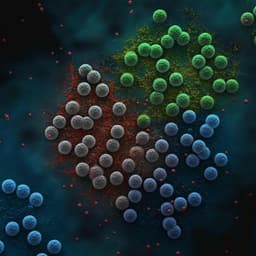
Medicine and Health
Multiple vaccine comparison in the same adults reveals vaccine-specific and age-related humoral response patterns: an open phase IV trial
M. V. D. Heiden, S. Shetty, et al.
This study explores the reduced vaccine responsiveness in older adults, revealing critical insights into how age influences humoral responses to various vaccines. Conducted by a team of experts, including Marieke van der Heiden and Sudarshan Shetty, the research highlights the challenges faced by older males in responding effectively to vaccines.
~3 min • Beginner • English
Introduction
The study addresses how age impacts humoral immune responses to different vaccines and whether low vaccine responsiveness is vaccine-specific or consistent across vaccine platforms within individuals. Aging is associated with immunosenescence and potentially sex-related effects, leading to reduced vaccine-induced immunity and shorter persistence. The authors highlight substantial inter-individual variability in responsiveness and the need to identify at-risk groups beyond chronological age, considering health metrics such as the Frailty Index. The primary aim was to compare 28-day humoral responses after a booster QIV and primary PCV13 and mRNA-1273 vaccinations among young, middle-aged, and older adults. Secondary aims were to compare 6-month persistence and to explore cross-vaccine response patterns within individuals and their associations with demographics and frailty to inform targeted vaccination strategies for older populations.
Literature Review
Prior work indicates vaccine responses decline with age due to immunosenescence and may be influenced by sex hormones, with non-heritable factors contributing substantially to immune variability. Studies report reduced efficacy and immune responses to influenza, pneumococcal, and SARS-CoV-2 vaccines in older adults, and differences in pre-vaccination immunity often confound age comparisons. The Frailty Index has been used to capture age-related health decline and has been associated with vaccine responses in some cohorts. There is limited head-to-head analysis of multiple vaccine responses within the same individuals, and evidence suggests vaccine responsiveness may vary by vaccine type (booster vs primary responses) and serotype-specific immunogenicity (e.g., pneumococcal serotype 3). Literature also notes sex differences in immune aging and potential faster immunological aging in males, supporting exploration of demographic correlates of low responsiveness.
Methodology
Design: Open-label, longitudinal phase IV intervention studies (VITAL and VITAL-corona) with consecutive vaccinations over ~2 years (2019–2021). Ethical approval: MREC Utrecht (NL69701.041.19; EudraCT 2019-000836-24). Participants: N=326 enrolled; N=315 per protocol for ≥1 vaccine (YA 25–49 y, MA 50–64 y, OA ≥65 y). Average ages: YA 36, MA 58, OA 76 years; male proportions: 34%, 41%, 53%. Inclusion required prior influenza vaccination (2018–2019). Exclusions included prior pneumococcal vaccination, immunodeficiency, high-dose corticosteroids, recent blood products, transplant, chemotherapy, asplenia, coagulation disorders, pregnancy at specific vaccinations, and recent vaccines or febrile illness before visits; additional exclusions for mRNA-1273 included recent monoclonal antibody treatment. Interventions: - QIV booster (Influvac Tetra 2019–2020) in autumn 2019. - PCV13 (Prevenar 13) primary vaccination in summer/autumn 2020. - SARS-CoV-2 mRNA-1273 (Spikevax) two-dose primary series in spring 2021 (1-month interval). Some older participants (n=43; mean age 84 y) received BNT162b2 via national program and analyzed separately. Sampling: Blood at pre-vaccination, 28±3 days, and 6 months (5–8 months; QIV long-term window extended up to ~12 months due to COVID-19 lockdown). Additional draws: 7±1 days post-PCV13 and at second mRNA-1273 dose. Assays: - Influenza H1N1 and H3N2 HI assays per WHO standards; HI titer >40 considered protective; responder defined as HI ≥40 at day 28 and >4-fold rise. - Pneumococcal serotype-specific IgG (13 serotypes) via fluorescent bead-based multiplex immunoassay calibrated to WHO 007sp; µg/mL. - SARS-CoV-2 Spike S1-specific IgG via bead-based assay calibrated to NIBSC 20/136; BAU/mL; seropositivity cut-off 10.1 BAU/mL (N-specific IgG cut-off 14.3 BAU/mL). Endpoints: - Primary: 28-day humoral responses by age group for booster (QIV) and primary (PCV13, mRNA-1273) vaccinations. - Secondary: 6-month persistence. Cross-vaccine responsiveness: 28-day titers partitioned into quartiles per vaccine; PCV13 serotype scores aggregated by majority vote to a vaccine score (1=lowest to 4=highest). Dual (QIV+PCV13) and triple (QIV+PCV13+mRNA-1273) response scores averaged across vaccines. Clustering: Unsupervised hierarchical clustering (Manhattan distance, Ward’s method) of ordinal response scores; elbow/nbclust for cluster number; heatmap visualization. Frailty metrics: Frailty Index (31 deficits, 0–0.53), EQ-5D-3L (Dutch norms), number of prescription medications. Statistics: Distribution checks; Kruskal–Wallis with Bonferroni for between-group comparisons; Wilcoxon signed-rank for paired; Levene for variance; Chi-squared for categorical proportions; Spearman correlations; linear mixed models (nlme) for longitudinal log-transformed responses with random intercept for time; effects package for predicted means with 95% CIs; significance p<0.05. Analysis in R and GraphPad Prism.
Key Findings
- Study population and analysis sets: 315 per protocol for ≥1 vaccine (YA n=59, MA n=95, OA n=161). Primary endpoint analyzed in: QIV n=307 (YA 56, MA 94, OA 157); PCV13 n=275 (YA 51, MA 84, OA 140); mRNA-1273 n=202 (YA 43, MA 75, OA 84). Dual vaccine data n=267; triple vaccine data n=190. - QIV (H3N2 HI): • Significant increases in H3N2 HI titers in all age groups at day 28 (p<0.0001). Responder rates (HI≥40 and >4-fold rise): YA 61%, MA 66%, OA 60%. • Day-28 H3N2 HI titers not significantly different between age groups; medians (min–max): YA 136.5 (5–1810), MA 80.0 (5–1280), OA 80.0 (5–1810). No correlation with age (r=−0.011, p=0.85). • Positive correlation between pre- and day-28 HI in all age groups (YA r=0.444; MA r=0.487; OA r=0.527). • Long-term (~6–12 months): Mixed model predicted lower titers in MA and OA vs YA (β MA=−0.60 [0.23], p=0.01; β OA=−0.50 [0.21], p=0.018). Predicted H3N2 HI [95%CI]: YA 77.93 [54.53–111.37], MA 42.97 [32.61–56.63], OA 47.0 [37.87–58.33]. • Proportion with HI<40 at long-term: YA 28.3%, MA 36.8%, OA 36.6%; under detection limit (<10): YA 3.8%, MA 13.8%, OA 16.2%. - PCV13 (13 serotype-specific IgG): • Day-28: Significant IgG increases for all serotypes across age groups (p<0.0001). Older adults had lower post-vaccination IgG for serotypes 1 (p=0.008 vs YA), 4 (p<0.0001 vs YA; p=0.002 vs MA), 6A (p=0.007 vs YA), 6B (p=0.0002 vs YA), 23F (p=0.0001 vs YA; p=0.01 vs MA). Middle-aged lower than young for serotypes 4 and 23F (p=0.002 and p=0.01). • Negative correlations between age and day-28 IgG for serotypes 1 (r=−0.156, p=0.009), 4 (r=−0.235, p<0.0001), 5 (r=−0.183, p=0.002), 6A (r=−0.146, p=0.015), 6B (r=−0.208, p=0.001), 23F (r=−0.251, p<0.0001). • Breadth of response: Fewer serotypes met responder criteria in MA (p=0.027) and OA (p<0.0001) vs YA. Proportion responding to ≥70% serotypes: YA 80% vs MA 58% (p=0.0084) and OA 48% (p<0.0001). Several serotypes had significantly fewer responders in OA (1, 4, 6A, 6B, 7F, 9V, 23F). • Longitudinal mixed models: At 7 days, OA had significantly lower IgG for all serotypes except 14 versus YA; MA lower for 1, 4, 23F. At 6 months, OA lower for 1, 3, 4, 6A, 6B, 23F versus YA; MA lower for 23F. - mRNA-1273 (Spike S1 IgG): • Cohort largely SARS-CoV-2 naive at baseline (few above seropositivity; N-IgG similar across age groups, p=0.61). • Day-28 after 2nd dose: Trend to lower S1 IgG in OA vs YA (p=0.065). Geometric means (BAU/mL, 95% CI): YA 2587.8 (2203.9–3038.5), MA 2217.9 (1874.5–2623.3), OA 1832.3 (1513.5–2218.3). Negative correlation with age (r=−0.165, p=0.02). • 6 months: Mixed model shows lower S1 IgG in OA vs YA (β=−0.48 [0.17], p=0.0071). Predicted S1 IgG [95%CI] BAU/mL: YA 414.3 [313.1–548.1], MA 323.9 [262.6–399.5], OA 257.6 [211.3–314.0]. All remained >10 BAU/mL; females in MA and OA had higher titers (p=0.02 both). • BNT162b2 sub-cohort (n=43; mean age 84): Day-28 geometric mean 629.3 BAU/mL (range 462.5–1036.0); at 6 months 88.1 (52.1–149.2) BAU/mL; 3 fell below 10 BAU/mL; trend of negative association with age (r=−0.279, p=0.07). - Cross-vaccine responsiveness: • No correlation between 28-day responses across QIV, PCV13, and mRNA-1273 (Supplementary Table 6). • Quartile-based scoring showed substantial within-individual variability across vaccines. Lowest dual-response group (QIV+PCV13) comprised 7.5% (n=20) and lowest triple-response group 8.9% (n=17); these were older and predominantly male (dual 70% male; triple 82% male) with lower pre-vaccination H3N2 titers; BMI, Frailty Index, EQ-5D-3L, medications did not differ. • Hierarchical clustering identified 9 response profiles; clusters included extremes: low-to-all (cluster 4, 16.8%) and high-to-all (cluster 7, 10.5%). Older adults appeared in all clusters with varying proportions. Low QIV clusters had lower baseline H3N2 titers. A slightly closer relationship was observed between QIV and mRNA-1273 responses than with PCV13. - Sex effects: Minimal for QIV; none for PCV13; higher S1 IgG in female MA and OA groups for mRNA-1273. - Persistence: Across vaccines, older adults showed shorter persistence of humoral responses at ~6 months.
Discussion
The study directly compared humoral responses to a booster influenza vaccine and two primary vaccines (pneumococcal conjugate and SARS-CoV-2 mRNA) within the same individuals across adult age groups. Findings show that when pre-existing immunity is present and a booster response is elicited (QIV), peak H3N2 HI responses can be comparable across ages. In contrast, primary responses (PCV13 and mRNA-1273) are diminished in older adults, with reduced breadth for PCV13 and lower peak S1 IgG for mRNA-1273. Persistence of antibody responses was shorter in older adults for all vaccine types, consistent with age-related declines in long-lived plasma cell survival and memory B cell function. Cross-vaccine analysis revealed marked inter-individual variability and vaccine-specific responsiveness, highlighting that immunosenescence progresses at different paces among individuals and that pre-vaccination immunity strongly shapes responsiveness to boosters. Nonetheless, approximately 10–15% of participants—predominantly older males with lower pre-vaccination H3N2 titers—were low responders across multiple vaccines, suggesting identifiable risk profiles for poor humoral responsiveness. No associations with frailty measures were evident, likely reflecting the relatively healthy, community-dwelling cohort. These insights support tailored vaccination strategies (e.g., timing, booster frequency, or vaccine choice) for at-risk subgroups rather than relying solely on chronological age.
Conclusion
This open phase IV study demonstrates that booster influenza vaccination can elicit comparable peak humoral responses across adult ages, whereas primary PCV13 and mRNA-1273 vaccinations yield lower antibody levels and breadth in older adults, with more rapid waning across all vaccines. Cross-vaccine profiling uncovers heterogeneous response patterns, but a notable minority—mainly older males with low baseline influenza titers—responds poorly to multiple vaccines. The work advances understanding of age- and vaccine-specific humoral immunity, identifies potential risk groups for low responsiveness, and underscores the importance of pre-vaccination immunity. Future research should elucidate cellular mechanisms (including memory and naive compartments, conjugate carrier responses), investigate antibody functionality, validate predictive biomarkers of responsiveness, and evaluate targeted strategies (e.g., adjuvants, dosing, schedules, or more frequent boosters) to optimize protection in aging populations.
Limitations
- Heterogeneous assay units across vaccines complicated direct comparisons; addressed via quartile-based scoring. - COVID-19 lockdown extended the QIV long-term sampling window to ~12 months; however, sampling distribution was similar across age groups. - The cohort included many healthcare workers among younger/middle-aged adults, potentially limiting generalizability. - Analyses focused on antibody concentrations without assessing functional activity or cellular immunity. - Exclusion of many oldest adults from the mRNA-1273 arm (due to receipt of BNT162b2 in the national program) likely reduced power for age comparisons. - The relatively healthy, community-dwelling older cohort and sample size limited detection of associations with frailty measures.
Related Publications
Explore these studies to deepen your understanding of the subject.







